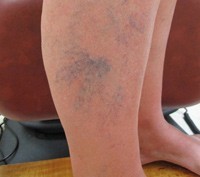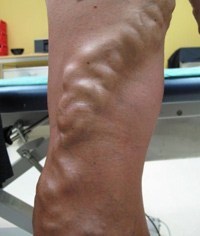Varicose Veins
Veins have valves that act as one-way flaps to prevent blood from flowing backwards as it moves up your legs. If the valves become incompetent, blood can leak back into the veins and collect there. (This problem is called venous insufficiency.) When backed-up increased pressure makes the veins swell and they can become varicose.
Leg veins range from tiny, superficial "spider veins" to large, blue "varicose" veins. Varicose veins are blood vessels that are abnormally dilated and consequently appear swollen, twisted and can be painful. They occur most commonly in the legs and feet. Spider veins (telangiectasia) are the smaller, abnormally dilated blood vessels visible in the skin. Varicose and spider veins appear as blue, purple, or red depending on depth, skin pigmentation and degree of stasis in the vessel.

Spider vein flare

Larger varicose veins
Causes
Inherited factors remains the most predictable component of predisposition to varicose veins. No single gene is responsible, however types of collagen in the vessel wall, response to healing, clotting tendancy, the activity of the immune system and general health all impact. Environmental factors can also have a quite strong influence and a job involving standing relatively still for long periods is a high risk factor as are multiple pregnancies and some types of trauma to the limbs. Spider veins are often responsive to hormones and onset at puberty, with pregnancy or at menopause is common in women. The latter cause can be more tenacious to deal with.
Treatment
An excellent first line treatment for spider veins on lower parts of the body is sclerotherapy. It is is safe, simple, and quick. The sclerosing solution is injected to the target site where the spider veins or varicose veins are present. The sclerosing solution irritates the lining of the blood vessel causing the vein to spasm and stick together. Over time, venous blemishes resolve and may disappear.
The number of veins treated and the number of treatments required depends on the size, extent and location of the veins. There is often a two week interval between first and second treatments and then a one month period to assess response. Sclerotherapy slowly clears leg veins and complete resolution can be expected in two to six months, depending on the vessel size. Spider veins on the face are treated with laser therapy or resistive thermolysis.
For treating larger veins, endo-luminal (EVLA or EVRF), surgical (stripping or phlebectomy) or sclerotherapy techniques may all be applicable and the best technique for the presentation should be chosen.

